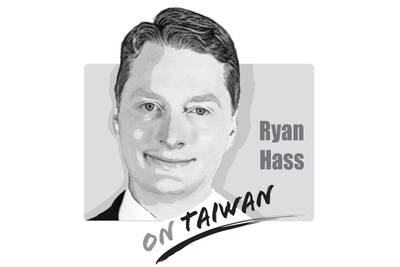"I have tried to keep the memory alive. I have tried to fight those who would forget. Because if we forget, we are guilty ... not to remember would turn us into accomplices of the killers, to remember would turn anyone into a friend of the victims."
So said Elie Wiesel, Holocaust survivor and renowned author, in his 1986 Nobel Peace Prize acceptance speech.
Yesterday marked the 61st anniversary of the 228 Incident, and to this day some of the victims' families still do not know why their loved ones were killed or where their remains lie.
Tens of thousands of society's elite -- ethnic Taiwanese and Mainlander alike -- were arrested, tortured and murdered during the brutal military crackdown that began in late February 1947. The Incident began a tragic page in Taiwan's history and ushered in the White Terror era.
Sadly, the commemoration of this catastrophic event has seemingly become a formality. Politicians visit the families of victims, hold memorial services, give speeches and all the rest of it, but what most of them will not tell their listeners is that increasing numbers of people -- and especially the younger generations -- are doing exactly what Wiesel so eloquently warned against: forgetting.
Talk to young people today and many, if not most, would be unable to offer even a brief account of what took place 61 years ago.
Some may dismiss this as inevitable, but this need not be the case -- if the government and people of high standing care enough about their history and its unjust legacy.
Schools in many Western nations include The Diary of Anne Frank in school curriculums. Other than a comic book treatment of Taiwanese history that was released some years ago, there is no material in local school curriculums that performs the corresponding function of educating young people about the 228 Incident and humanizing its victims.
Young Taiwanese may shed the odd tear while watching Schindler's List, yet how many would feel a sense of connection when stories of the 228 Incident are told at commemorative services?
Chinese Nationalist Party (KMT) presidential candidate Ma Ying-jeou (
This is a welcome suggestion, but a fairly token one in the context of the ongoing lack of accountability of the KMT in relation to its stolen assets, ideological scars and autocratic residue -- the survival of which owes everything to the 228 Incident and what followed.
If Ma felt for the 228 Incident's victims and the agony suffered by their families, then he would have castigated his party for once again blocking a budget in the legislature that would have provided more support for the victims and their families.
We hear a lot from self-congratulatory Taiwanese about our democracy. But the meaning of "Taiwanese democracy" and its citizens' ability to defend it are tempered by the reality that more and more Taiwanese know nothing about -- and sometimes cruelly rationalize -- this nation's dirty history.
The last thing any person of conscience would hope to see is 228 Memorial Day following in the footsteps of other holidays, in which people vaguely do the "right thing" out of sheer habit and lack understanding of what the day represents.
As ordinary Taiwanese increasingly seek to depoliticize their lives, and as politicians turn the crimes of their fathers into their own political capital, this may turn out to be little more than a pipe dream.
The diplomatic dispute between China and Japan over Japanese Prime Minister Sanae Takaichi’s comments in the Japanese Diet continues to escalate. In a letter to UN Secretary-General Antonio Guterres, China’s UN Ambassador Fu Cong (傅聰) wrote that, “if Japan dares to attempt an armed intervention in the cross-Strait situation, it would be an act of aggression.” There was no indication that Fu was aware of the irony implicit in the complaint. Until this point, Beijing had limited its remonstrations to diplomatic summonses and weaponization of economic levers, such as banning Japanese seafood imports, discouraging Chinese from traveling to Japan or issuing

There has been much catastrophizing in Taiwan recently about America becoming more unreliable as a bulwark against Chinese pressure. Some of this has been sparked by debates in Washington about whether the United States should defend Taiwan in event of conflict. There also were understandable anxieties about whether President Trump would sacrifice Taiwan’s interests for a trade deal when he sat down with President Xi (習近平) in late October. On top of that, Taiwan’s opposition political leaders have sought to score political points by attacking the Lai (賴清德) administration for mishandling relations with the United States. Part of this budding anxiety
The diplomatic spat between China and Japan over comments Japanese Prime Minister Sanae Takaichi made on Nov. 7 continues to worsen. Beijing is angry about Takaichi’s remarks that military force used against Taiwan by the Chinese People’s Liberation Army (PLA) could constitute a “survival-threatening situation” necessitating the involvement of the Japanese Self-Defense Forces. Rather than trying to reduce tensions, Beijing is looking to leverage the situation to its advantage in action and rhetoric. On Saturday last week, four armed China Coast Guard vessels sailed around the Japanese-controlled Diaoyutai Islands (釣魚台), known to Japan as the Senkakus. On Friday, in what
On Nov. 8, newly elected Chinese Nationalist Party (KMT) Chairwoman Cheng Li-wun (鄭麗文) and Vice Chairman Chi Lin-len (季麟連) attended a memorial for White Terror era victims, during which convicted Chinese Communist Party (CCP) spies such as Wu Shi (吳石) were also honored. Cheng’s participation in the ceremony, which she said was part of her efforts to promote cross-strait reconciliation, has trapped herself and her party into the KMT’s dark past, and risks putting the party back on its old disastrous road. Wu, a lieutenant general who was the Ministry of National Defense’s deputy chief of the general staff, was recruited